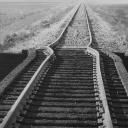Yahoo Answers is shutting down on May 4th, 2021 (Eastern Time) and beginning April 20th, 2021 (Eastern Time) the Yahoo Answers website will be in read-only mode. There will be no changes to other Yahoo properties or services, or your Yahoo account. You can find more information about the Yahoo Answers shutdown and how to download your data on this help page.
Trending News
question related to train running on track, corrosion and friction..?
The top surface of the track is rust-free because of passage of train wheels and friction between the wheel and track.. the friction produced is used for running fans and tubelights inside the train.. but does the rust play any role in it? i have got a project on railway corrosion.. i want to know that if in this process, does rust play any role? if in any other way, it does, please do tel that. and can u please tell me, what are the new technologies in preventing rust of railway tracks, trains and engines?
thank u :)
3 Answers
- The ChielLv 69 years agoFavorite Answer
The dynamo or alternator fitted to older railway carriages is usually driven by pulleys and belts from one of the axles, and the presence of rust or otherwise has no bearing on this. The running surface of the pulleys will remain free of corrosion in the same way that the rail surfaces do. The wheel bearings and bearings of the alternator/dynamo will be lubricated in any case, and will therefore not corrode.
I am not aware that there are any 'new technologies' in preventing rust to railway equipment. Good old-fashioned paint seems to do the job adequately. However, some passenger carriages, and even some locomotives now have their livery details - especially complicated graphics - applied using adhesive-backed printed vinyl sheets. However, the sides of the vehicles are previously painted in the normal way.
Freight vehicles are more problematic, as they get knocked about to a greater or lesser extent in their day-to-day work, damaging the paintwork and allowing the ingress of water. There is no solution, other than to build such cars from heavy-gauge steel sheet, and be prepared to 'patch and weld' when necessary!
Source(s): Retired UK Train Driver, lifetime of interest - DerailLv 79 years ago
The fact of manufacturing from mined metals, is that corrosion begins (in a technical sense) the day any item is manufactured. There is longevity in what is produced, but there is always rust on any manufactured item. Painting and maintenance slows the process, but corrosion can never be entirely eliminated.
Rails last a long time, and in fact, I have seen rails in little used sidings or industry tracks going back to the 1890s and even the 1880s. These are lighter weight rails intended for the lighter weight trains of the time, but obviously still work (with some caution) for a few seldom used industries. Yes, they're rusty, but their original profile has not been distorted with the loss of material due to rust.
One of the railroads I worked for used to store cars for other railroads. They would sit for months and even a few years at a time. If I was the one to go retrieve a cut of cars to bring back into town, I noticed that surface rust on the rail would impede traction and cause the locomotive wheels to slip. Not a lot however, but just tended to slip a little easier than a shining well used rail. One would think that this rust powder would enhance adhesion like sand would. But it didn't. The rust acted as a material preventing a solid contact between the wheels and the rail. I have to point out that this wasn't a big problem, and was quickly remedied with just one or two passes over the rail.
Source(s): Engineer - Anonymous9 years ago
Rust plays no role, because as you already stated, there is no rust in rail that is traveled frequently.
Corrosion protection is not an issue on railroad tracks, because there is no significant corrosion on tracks that are constantly in use.
Rail wears out from flange friction and passage of wheels long before there is a corrosion problem.
A railroad track can sit idle for years and years, and there will only be a light layer of surface rust that is of no significancte to the passage of trains.
Source(s): RR engineer, U.S.



